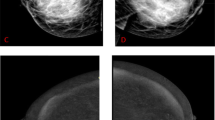Abstract
Background
Contrast-enhanced spectral mammography to compare clinical efficacy of contrast-enhanced spectral mammography (CESM) and conventional digital mammography (MMG) with histopathology as gold standard in dense breasts.
Patients and methods
A total of 143 breasts of 72 women who underwent CESM and MMG between 2011 and 2014 at Showa University Hospital were analyzed.
Results
129 (90.2 %) of 143 breasts revealed dense breasts on MMG. 58 (40.6 %) of 143 breasts were diagnosed with breast cancer at histopathology. The remaining 85 breasts were diagnosed with benign findings after image assessments and/or core needle biopsy. CESM revealed 8 false-negative cases among 58 breast cancer cases (sensitivity 86.2 %) and 5 false-positive cases (specificity 94.1 %). Accuracy was 90.9 %. Conventional MMG was assessed true positive in 31 of 58 breast cancer cases (sensitivity 53.4 %) and false positive in 12 cases (specificity 85.9 %). Accuracy was 72.7 %. Sensitivity (p < 0.001), specificity (p = 0.016) and accuracy (p < 0.001) were significantly higher on CESM compared to MMG. MMG missed malignancy in 27 breasts. Of these, 25 were dense breasts. Of these 25, 20 (80.0 %) breasts were positive on CESM.
Conclusion
These findings suggest that CESM offers superior clinical performance compared to MMG. Use of CESM may decrease false negatives especially for women with dense breasts.



Similar content being viewed by others
References
Kolb TM, Lichy J, Newhouse JH. Comparison of the performance of screening MMG, physical examination, and breast US and evaluation of factors that influence them: an analysis of 27,825 patient evaluations. Radiology. 2002;225(1):165–75.
Byrne C, Schairer C, Wolfe J, Parekh N, Salane M, Brinton LA, et al. Mammographic features and breast cancer risk: effects with time, age, and menopause status. J Natl Cancer Inst. 1995;87:1622–9.
Warner E, Lockwood G, Tritchler D, Boyd NF. The risk of breast cancer associated with mammographic parenchymal patterns: a meta-analysis of the published literature to examine the effect of method of classification. Cancer Detect Prev. 1992;16:67–72.
Brisson J, Merletti F, Sadowsky NL, Twaddle JA, Morrison AS, Cole P. Mammographic features of the breast and breast cancer risk. Am J Epidemiol. 1982;115:428–37.
Boyd NF, Byng JW, Jong RA, Fishell EK, Little LE, Miller AB, et al. Quantitative classification of mammographic density and breast cancer risk: results from the Canadian National Breast Screening Study. J Natl Cancer Inst. 1995;87:670–5.
Ursin G, Ma H, Wu AH, Bernstein L, Salane M, Parisky YR, et al. Mammographic density and breast cancer in three ethnic groups. Cancer Epidemiol Biomar- kers Prev. 2003;12:332–8.
Mammography Reporting System. ACR BI-RADS Atlas 5th Edition. American College of Radiology; 2013. p.121–140.
Pisano ED, Hendrick RE, Yaffe MJ, Baum JK, Acharyya S, Cormack JB, et al. Diagnostic accuracy of digital versus film mammography: exploratory analysis of selected population subgroups in DMIST 1. Radiology. 2008;246(2):376–83.
Fallenberg EM, Dromain C, Diekmann F, Renz DM, Amer H, Ingold-Heppner B, et al. Contrast-enhanced spectral mammography: doesmammography provide additional clinical benefits or can some radiation exposure be avoided? Breast Cancer Res Treat. 2014;146(2):371–81.
Lobbes MB, Lalji U, Houwers J, Nijssen EC, Nelemans PJ, van Roozendaal L, et al. Contrast-enhanced spectral mammography in patients referred from thebreast cancer screening programme. Eur Radiol. 2014;24(7):1668–76.
Cheung YC, Lin YC, Wan YL, Huang PC, Lo YF, Tsai HP, et al. Diagnostic performance of dual-energy contrast-enhanced subtracted mammography in dense breasts compared to mammography alone: interobserver blind-reading analysis. Eur Radiol. 2014;24:2394–403.
Chen Z, Wu AH, Gauderman WJ, Bernstein L, Ma H, Pike MC, et al. Does mammographic density reflect ethnic differences in breast cancer incidence rates? Am J Epidemiol. 2004;159(2):140–7.
del Carmen MG, Halpern EF, Kopans DB, Moy B, Moore RH, Goss PE, et al. Mammographic breast density and race. AJR Am J Roentgenol. 2007;188(4):1147–50.
Ellison-Loschmann L, McKenzie F, Highnam R, Cave A, Walker J, Jeffreys M. Age and ethnic differences in volumetric breast density in New Zealand women: a cross-sectional study. PLoS One. 2013;8(7):e70217.
Colin C, Schott AM, Valette PJ. Mammographic density is not a worthwhile examination to distinguish high cancer risk women in screening. Eur Radiol. 2014;24(10):2412–6.
Author information
Authors and Affiliations
Corresponding author
Ethics declarations
Conflict of interest
The authors declare that they have no conflict of interest.
About this article
Cite this article
Mori, M., Akashi-Tanaka, S., Suzuki, S. et al. Diagnostic accuracy of contrast-enhanced spectral mammography in comparison to conventional full-field digital mammography in a population of women with dense breasts. Breast Cancer 24, 104–110 (2017). https://doi.org/10.1007/s12282-016-0681-8
Received:
Accepted:
Published:
Issue Date:
DOI: https://doi.org/10.1007/s12282-016-0681-8




